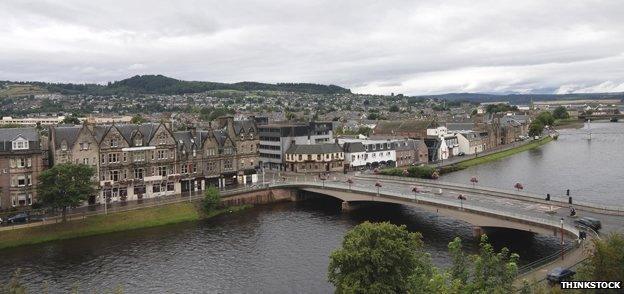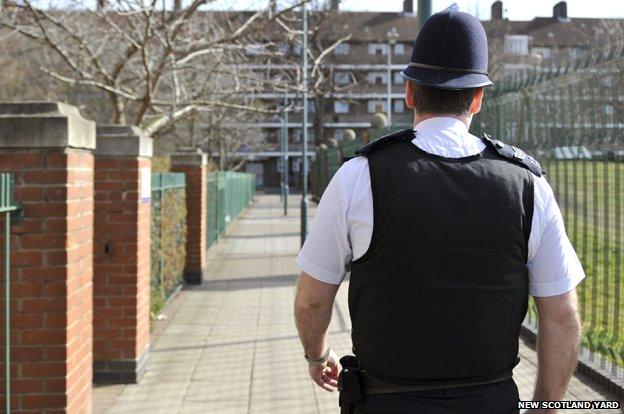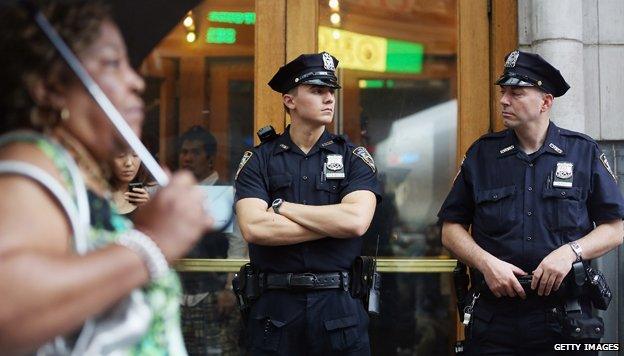The British police on armed routine patrol
- Published

This picture with armed officers attending a routine disturbance sparked controversy
In a little-noticed move, a small number of police officers are now routinely carrying sidearms while on patrol in parts of the mainland UK. How did this come about, and does it alter the relationship between the constabulary and the public?
Saturday night in Inverness. Outside a McDonald's restaurant, a scuffle between two men breaks out. Three police officers arrive to intervene. So far, so mundane.
Except that strapped around the hips of each of the policemen approaching the brawl is a holstered Glock 17 semi-automatic pistol.
It's a sight that once would have been unthinkable. In this corner of the Scottish Highlands - an area with one of the lowest crime rates in the UK - the officers showing up to a relatively workaday disturbance are armed.
Although every police force has a firearms unit, for decades it has been an article of faith that in the mainland UK, almost uniquely among major industrialised nations, the police do not carry guns as a matter of course.
But with little fanfare at first, a policy of routinely allowing specialist officers to wear sidearms as they walk the streets of Scotland has come into being.

Inverness has a low crime rate by the standards of many cities
After the incident in Inverness was captured by a local photographer on 12 July, local politicians expressed fears that the tradition of an unarmed constabulary was being surreptitiously eroded - a charge that would have implications for everyone in the UK.
John Finnie, an independent Member of the Scottish Parliament and former police officer, was approached by a constituent who said he had seen armed officers at the finishing line of the Highland Cross biathlon, external in the sleepy town of Beauly. The man told the MSP he "felt less safe", assuming some sort of major incident was under way.
Other sightings of armed officers in incongruous settings had emerged - at a bakery in the village of Brora, external, at a branch of Aldi in Inverness., external They were also photographed at a routine traffic incident in Glasgow city centre., external
Police Scotland, the single Scotland-wide force, says when specialist officers are not deployed on active firearms duty, it is expected that they carry out normal policing duties while carrying their sidearms. It says it is not the first force in the UK to routinely arm officers, and that 42 forces in England and Wales "carry the same standing authority and deploy similarly".
There seems however to be a lack of clarity about how widespread the practice is. A spokesman for the Association of Chief Police Officers says Police Scotland's policy has precedents in London in 2009 and Bedfordshire in 2012. The Metropolitan Police, however, says its officers on routine patrols are not armed.
This policy was introduced by the former Strathclyde force in 2008, and followed by Tayside in 2009 and Northern Constabulary just before the single force was created in 2013. Hitherto, firearms officers had to retrieve their weapons under a senior officer's authorisation from a locked safe in an armed response vehicle.
Until this point, most people hadn't actually noticed that the policy had altered. Jimmy Gray, the leader of Highland Council, says Northern Constabulary's Joint Police Board was not fully informed, external what the change would mean. "It horrifies most people around here," he says.

The British position

A 2006 survey of 47,328 Police Federation members found 82% did not want officers to be routinely armed on duty.
For decades there have been incidents that have led to calls for issuing all officers with firearms.
While some in London were issued with revolvers before 1936, from that date only trained officers at the rank of sergeant or above were issued with guns. Today only a small proportion of officers are authorised to use firearms.
In London, the sight of armed officers at airports, embassies and other security-sensitive locations has become a familiar one

Following an outcry, however, the Scottish Justice Minister Kenny MacAskill addressed MSPs, external at Holyrood on Tuesday to defend it. He said the public "understands and accepts" the need for a "small number" of officers to be armed and for the chief constable of Police Scotland, Sir Stephen House, to have operational independence over their deployment.
But in the Highlands, where 16 officers are authorised to routinely carry sidearms, hostility remains strong among elected representatives, who fear that the change in tactics will only encourage criminals to arm themselves more heavily.
Finnie, MSP for the Highlands and Islands, has led the opposition in the Scottish Parliament. He says it is unnecessary as officers are walking around "the safest place in the UK" with sidearms, and that the policy will only serve to frighten people.
Critics pointed out the widening of the policy comes after figures for 2012-13 showed firearm offences in Scotland had fallen by 32% to the lowest for 10 years. Homicides, attempted murders and robberies in which firearms were involved were all down too.
Petitions opposing the policy were started by local MP Danny Alexander and the Inverness Courier newspaper. Some 59 of 80 Highland councillors supported a motion tabled at the full council calling for a review.
But following a meeting with Highland councillors in July, divisional commander Ch Supt Elaine Ferguson said the policy was unlikely to change.
Ever since Robert Peel created the Metropolitan Police in 1829, the British force's unarmed status has been central to its identity. Some in London were issued with revolvers prior to 1936, but after that date only trained officers ranked at sergeant or above were issued with guns, and even then only if they could show a good reason.
This was underpinned by the principle of policing by consent - the notion that officers owe their primary duty to those they serve, rather than to the state. Historically the only forces in the UK which were routinely armed were in Northern Ireland, the Ministry of Defence Police and the Civil Nuclear Constabulary.
According to Richard Garside, director of the Centre of Crime and Justice Studies, the sight of armed police has become more common in recent decades at airports and at places like the House of Commons. Cases like the murder of PC Sharon Beshenivsky, shot dead during a robbery in 2005, or of the three plain-clothes officers murdered by Harry Roberts in west London in 1966, have led to calls for the police to be armed.

The international model

All major police forces in Europe, as well as the US, Canada and Australia routinely carry firearms
The exceptions are Britain, the Irish Republic and New Zealand
In Norway officers carry arms in their cars but not on their person
New Zealand has adopted an armed response model similar to Britain, according to the International Law Enforcement Forum

In November 2011, Met Commissioner Bernard Hogan-Howe called for police response officers to be routinely armed with Tasers and in 2007 the centre-right think-tank Policy Exchange found 72% of 2,156 adults wanted to see more armed police patrols.
But a 2006 survey of 47,328 Police Federation members found 82% did not want officers to be routinely armed on duty, despite almost half saying their lives had been "in serious jeopardy" during the previous three years.
Nonetheless, Garside says the policy in Scotland represents an "escalation" and will appear surprising to a public which still cherishes a Dixon of Dock Green ideal of policing.
"It does change the dynamic between the police and the public," he says. "It's always slightly alarming or unusual to see police officers in the UK carrying guns."
Police Scotland insists that it is a long way from routinely arming those who serve in it. There has been no increase in the number of armed personnel. Out of 17,318 Scottish officers, only 275 routinely carry guns while on duty - 1.6% of the total. Because they work shifts, a much smaller number will be on duty at any one time.
In a statement,, external Deputy Chief Constable Ian Livingstone said the change in policy was necessary to correct a "previous postcode lottery of services", adding that shootings in Dunblane, Cumbria, Hungerford and Northumberland demonstrated that rural areas were not immune from the threat of gun crime.
He added that it made sense for armed officers "to support their colleagues in local policing divisions through regular patrols and routine tasks" when they are not carrying out their specialist duty - citing the example of a 79-year-old woman who was rescued from the Caledonian Canal in Inverness by armed officers, who were the closest unit on hand to assist.
But Finnie says it isn't necessary for them to wear sidearms strapped to their hips while they carry out this kind of assistance. During his 10 years as a dog handler, he says, he would regularly be called to assist colleagues dealing with robberies or domestic violence incidents, but "I didn't take my 90lb snarling animal along with me".
In addition, Dr Mick North, whose five-year-old daughter Sophie died at Dunblane Primary in 1996, hit out, external at the force for citing the tragedy in support of its policy. He said changes to the system would not have helped as "the incident was all over in three minutes".
Police Scotland say they have only received one complaint from a member of the public about the policy, but a quarterly review in September "will take account of the views raised so far".
Subscribe to the BBC News Magazine's email newsletter to get articles sent to your inbox.